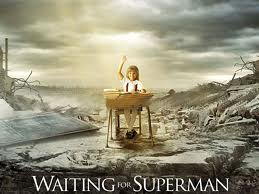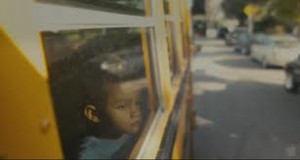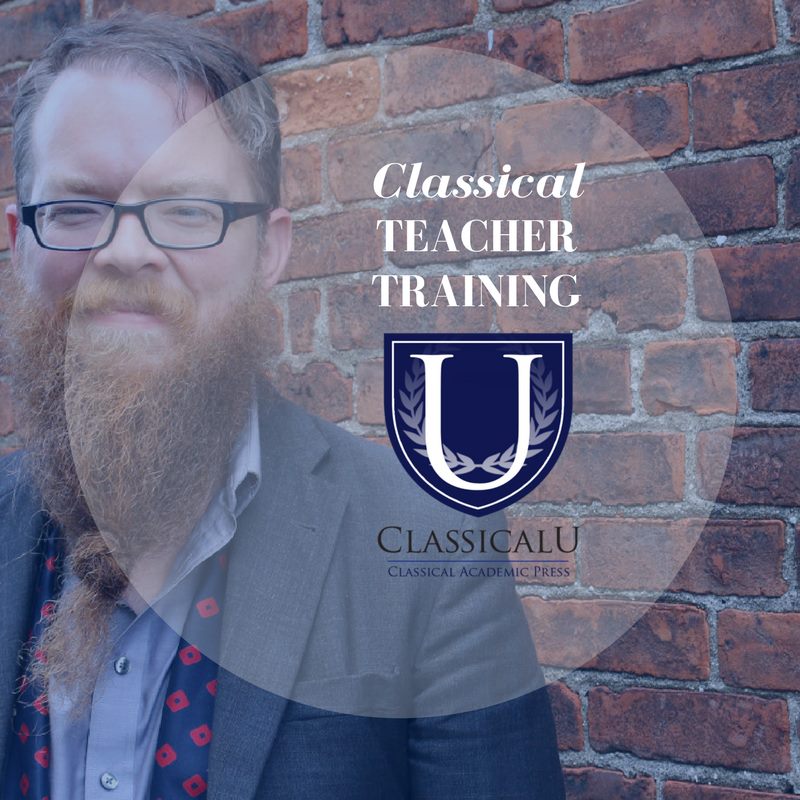Waiting for Superman (Paramount Pictures)
Christopher A. Perrin
It is hard to watch David Guggenheim’s documentary Waiting for Superman without leaning into the screen with anticipation and hope, only to droop with disappointment, yes even despair. It is the kids that do that to you—real children with real dreams, bright and earnest, brimming with surprising potential, supportive parents or grandparents, hoping and praying they can be one of the few selected (by lottery) to attend a promising charter school. They don’t get in (with two exceptions).
Daisy is a Hispanic elementary student from a challenging section of Los Angeles (East LA). The camera follows her for most of a year, recording her at school and home diligently studying, talking excitedly about her dreams to be come a veterinarian. After watching her for a few months, you have no doubt she could become veterinarian (or just about anything else.). Her extended family pulses with her potential, believes in her, as you do. If she stays in her public school system, her chances of going to college are virtually nil. A local charter school offers hope—the camera reveals the charter school is doing excellent work and could keep her on her dream’s path. After getting to know Daisy and her family, you watch her sitting in the public lottery, fingers crossed, with hundreds of other students all vying and praying for one of the few spots at the school. She doesn’t get in. She will have to attend her local middle school, which has a 40% graduation rate (from eighth grade). And so it goes with several other hopeful students followed by Guggenheim’s camera.
The film gives the impression that Guggenheim is no natural critic of public, government education and that perhaps he would have liked to put his own children in a public school in Los Angeles. Diane Ravitch (in her critical review of the film: http://www.nybooks.com/articles/archives/2010/nov/11/myth-charter-schools/?page=1) points out that Guggenheim himself attended Sidwell Friends, an elite preparatory school in Washington, D.C. (Obama’s children attend Sidwell). Whatever his predispositions toward public education, when his children became of school age he simply could not seriously consider enrolling his children in the local public school. For him, the raw data was persuasive: too many students were getting lost in the school system, unable to realize their academic potential, far too few even graduating from high school (in some cases below 20%). What was going wrong inside these schools? He set out to find out and produced Waiting for Superman (he also produced An Inconvenient Truth, about global warming) and enrolled his children in a private school—because he could afford to.
What goes wrong in these schools is nothing new to anyone even generally familiar with urban, public education. Bad teachers can’t easily be removed. Even with significant funding, good books and supplies are scarce (and often poorly treated or destroyed by students). Students disrespect teachers and teachers endure students. Resolute administrators become disillusioned and give up, or become opposed (by powerful teacher unions) and forced out. Schools lack a culture of study, rigor, discipline or optimism and instead become soul-squelching institutions dominated by popular youth culture and the culture of the street. All this is nothing new. What is new is what the eye of the camera reveals. We don’t just hear it, we see it, and we see the Daisys of the world being lost.
We also see some remarkable people working for change. Michelle Rhee (former superintendent of Washington, D.C. schools tell us of her experience trying to reform one of the worst-performing school districts in the nation. She worked valiantly, was opposed venomously, then removed when a new mayor was elected (campaigning that he would remove her if elected). Rhee concludes that the biggest obstacles to reforming the D.C. district is not money or curriculum but the teachers themselves (not all, perhaps not most, but enough) who are more concerned with their job security (tenure) than students and their welfare.
Another administrator with Kipp charter schools (http://www.kippny.org/) is doing noble work providing a superb education to minority students in Harlem. Kipp seems to prove that poverty does not keep students from an excellent education—bad schools do. The Kipp charter school in Harlem has a 96% graduation rate. Guggenheim notes that he used to believe that bad (poor) neighborhoods made for bad schools. Now he believes bad schools cause bad neighborhoods.
Who is waiting for Superman? The children are, and it appears he is not coming. These students need rescue—rescue from their failing, dis-affecting, de-humanizing schools. If there are any heroes in the film it is the courageous administrators and teachers of several charter schools that have been started and succeeded (almost against all odds) right amidst a ring of failing schools. Clearly, Guggenheim thinks we must offer students like Daisy something different and better, like innovative charter schools. After watching the film it is hard to disagree.
However, even great charter schools lack something vital—the freedom to engage the culture of the Christian west and her queen, theology. We must settle for a secular rigor and an eclectic and unstable curriculum. Put another way, we must settle for getting urban kids to suburban standards. Still secular, still likely encumbered with all the challenges of our better suburban public schools, but still better.
As well, we must ask ourselves if Guggenheim is telling all the critical parts of the story. He admits that only one in five (20%) charter schools are succeeding. He does not show any examples of successful public schools in urban settings. He chooses not to tell us the remarkable amount of money that is spent at some of these charter schools (in his film) that receive public and private funding. The organization that runs the Kipp schools, for example, has over $200 million in assets and provides students with an extensive array of social and medical services. The boarding school featured in Washington, D.C., spends $35,000 per year on each student. In other words, the charter schools that Guggenheim features are funded well beyond typical public (and private!) schools. With this kind of funding, can we really regard such students as impoverished? Diane Ravitch (a prominent historian of education) points to studies that show that only 17% of charter schools are out-performing comparable public schools, that 37% are performing worse than public schools and that 46% are performing the same as public schools.
Ravitch thinks that Guggenheim is engaging in artistic propaganda and special pleading, even while highlighting urgent problems and some remarkable successes. For Ravitch, poverty is a chief causal factor contributing to student performance and thus school achievement. What she doesn’t make explicit (but seems to assume) is that urban families are in crisis and in fact disappearing as in-tact supportive communities. Without a supportive family, a student can rarely succeed in a public, charter, private or classical Christian school. Now there is a relationship between poverty and family cohesiveness, but being poor (as hard as that is) does not cause the disintegration of a family. Poverty is not, per se, a sin nor does it cause sin, though it brings its peculiar temptations even as wealth does.
Something beyond mere poverty is at play, destroying American families, not only in the cities but in the suburbs. Urban families, however, are clearly in greater crisis and no doubt poverty is exacerbating the family breakdown. Leaving aside, for the moment, the complex nexus of factors making war on the American family, we should remember that schools can teach but not single-handedly resuscitate a family dying from a hundred wounds. Not even great classical Christian schools. Schools cannot effectively serves as social welfare agencies, health care providers, churches, or surrogate mothers and fathers. As Jacques Barzun pointed out long ago (in Teacher in America), schools can teach but not educate, for to “educate” requires a congenial collaboration among parents, families, friends, supporters, churches, teachers, administrators and students. Ravitch notes that all the families in Waiting for Superman are supportive and invested in the education of their children (special pleading again). The reality is that far too many families are broken and unable to support and encourage their children generally, much less follow and support their education. Guggenhiem seems to think that a local charter schools can change all this. He thinks, in fact, that it is failing schools that make for failing neighborhoods—as if the local school has done the most to cause the breakdown of urban culture and families.
Causation (as philosophers and scientists will tell us) is tricky and hard to pin down. Our urban culture is suffering on account of multiple causes in my view, not the least of which is the ubiquitous, invasive influence of secular mass media that is shaping the souls of our American youth in and out of the cities. James K. A. Smith has pointed out the various ways “secular liturgies” from the mall to the athletic field to the movies to Facebook are powerfully forming our youth to love a secular ideal of human flourishing much different that the New Testament ideal of the Kingdom of God (Desiring the Kingdom: Worship, Worldview and Cultural Formation). Which leads me to say that without the revival of city churches urban schools (of any stripe) will have a greatly diminished impact. A great urban school cannot do all that is needed. In fact an urban school can only become great when urban churches support it and compliment it with their own vibrant ministries to families. Christian educators cannot flee to schools as the best means of reviving our urban youth and families. Rather churches, schools and families must form vital partnerships if there is any hope of creating culture and cultivating students not just as future workers but human souls.
Private Christian educators should take note of Guggenheim’s film, but view it critically. He does engage in special pleading, generalizing and one two many straw men. He does not assess the vital role of supportive families or churches in providing education and supporting local schools. His use of statistics has been questioned (effectively by Ravitch). He does, however, powerfully portray the sad state of many urban public schools and the plight of many urban youth, who at present have no choice but to attend a school that will fail them as it has others. By providing a few shining examples of remarkably successful charter schools (even if very well-funded), he suggests it could happen again and elsewhere.
Christians should not wait for public funding or a public charter to offer hope to Daisy and thousands like her. While it will take immense sacrifice of time and resources, it is now time for the accrued wisdom and experience of the last 30 years of renewing classical and Christian education to be brought to bear to start schools in all the major cities in the U.S. This is already beginning to happen, but needs to extend and expand. The Oaks Academy (http://www.theoaksacademy.org/) in Indianapolis, IN is providing a superb liberal arts education to students in that city. Logos Academy of York, PA (http://www.logosyork.org/) is doing the same there. Mortimer Adler quipped that best education for some (meaning a robust liberal arts education) is the best for all. Some of us have been able to afford to give a recuperated, if imperfect classical education to our own children. Are we now ready to give it to others who otherwise will never receive it? They are wanting and waiting













Just wanted to offer a note of hope, Daisy was actually accepted into her school a few months down the road. I have friends who work at a Kipp school and respect the efforts they are putting forth to change lives. They WISH they could accept more students, but when you have 4th graders who don’t know what a sentence is, they can only do so much. I am amazed by the sacrifice my friends give for the students in their school, they work SO hard all year round.
Samantha,
I am glad to hear the news about Daisy…and I have no doubts she will become a veterinarian if that is what she wants.
–CP
As an administrator at a similar high-performing urban charter school, I see both sides of what Dr. Perrin discusses – both the important opportunities that we offer our students, but also the degree to which our program falls short of the admirable classical ideal, which would be especially of benefit to kids most in need. I am looking to help develop such a program at some point, and would be happy to hear from others of similar interest!
As an administrator at a high-performing charter school, I see both sides of what Dr. Perrin discusses – both the important opportunities that we offer our students, but also the degree to which our program falls short of the admirable classical ideal, which would be especially of benefit to kids most in need. I am looking to help develop such a program at some point, and would be happy to hear from others of similar interest!
Great review. The film was thought provoking to say the least. (I did a short review on my blog as well.) How do those of us in the classical Christian school movement provide an excellent education to urban kids? Cost certainly has to be not only a factor, but THE factor. I’d like to hear your thoughts on creative ways to fund Christian schools.
Bob, I would be glad to put you in touch with others who are working in similar schools with similar goals. Email me at info@classicalsubjects.com.
–CP
Chris – Fantastic write-up. I love your holistic view – born of deep experience and observation – of the problem and solution. I appreciate your assessment from the ground floor and from the treetops.
What she did was great. im proud of her.